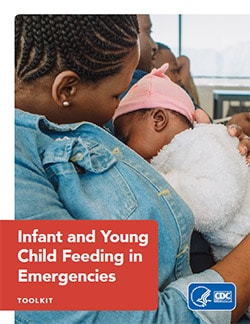Feeding Your Child Safely During a Disaster

Natural disasters, such as hurricanes, floods, wildfires, earthquakes, and tornados, can make it hard for parents and caregivers to feed their infants and young children safely. Follow these tips to feed your child safely when disaster strikes.
For Parents and Caregivers
In the event of a natural disaster, be prepared for challenges, which may include power outages, unhealthy living spaces, and unsafe water. Always check with local authorities on the status of the drinking water and follow boil water advisories. The following tips provide specific information for how to feed your young child safely during an emergency.
Breastfeeding
If you need help obtaining nutritious food, see resources at USDA Nutrition Assistance Program. You can also call the USDA National Hunger Hotline at 1–866–3–HUNGRY or 1–877–8–HAMBRE to find resources such as meal sites, food banks, and other social services.
Breastfeeding remains the best infant feeding option in a natural disaster situation. Breast milk helps protect babies from diseases such as diarrhea and respiratory infections and provides the calories and nutrients babies need. This protection is especially important during natural disasters when contaminated water and unsanitary environments can increase the risk of disease. Before a disaster happens, breastfeeding mothers can make a plan [PDF-1.3 MB] and be prepared.
- Wash your hands before feeding your infant. If soap and safe water are not available, use an alcohol-based hand sanitizer that contains at least 60% alcohol.
- Learn how to express breast milk by hand. If there is a power outage, you may not be able to use your electric breast pump.
- Continue breastfeeding in emergencies.
- During and after a disaster, stay with your child. Staying together makes it much easier to continue breastfeeding.
Formula Feeding
CDC’s Infant and Young Child Feeding in Emergencies (IYCF-E) Toolkit provides information and resources for emergency preparedness and response personnel, families, and the public to ensure that children are fed safely when disaster strikes. Learn more.
- Wash your hands before preparing formula and before feeding your infant. If soap and safe water are not available for handwashing, use an alcohol-based hand sanitizer that contains at least 60% alcohol.
- If you formula feed your child, provide ready-to-use infant formula [PDF-836KB] if available. Ready-to-use infant formula is a type of infant formula that is packaged as ready-to-feed liquid and does not need to be reconstituted with water. If ready-to-use infant formula is not available, it is best to use bottled water to prepare powdered formula or concentrated formula when tap water is unsafe.
- If bottled water is not available, boil water for 1 minute and let it cool before mixing with formula. Only use treated water to prepare formula if bottled or boiled water is unavailable. Learn how to prepare and store powdered infant formula during an emergency.
- If your baby is younger than 2 months old, was born prematurely, or has a weakened immune system, consider taking extra precautions to safely prepare powdered infant formula.
Breastfeeding and Formula Feeding
- If you already combine breastfeeding and formula feeding, you may wish to breastfeed more often to increase your breast milk supply and reduce reliance on formula.
- Always clean infant feeding items with bottled, boiled, or treated water and soap before each use. If you cannot clean infant feeding supplies safely, children can lap up milk from a disposable cup, if available. Throw out bottle nipples or pacifiers that have been in contact with floodwater.
For Parents
- Infant and Young Child Feeding in Emergencies (IYCF-E) Toolkit | Nutrition | CDC
- Preparedness for Expectant and New Parents
- Food and Water Safety After a Disaster or Emergency
- Caring for Children in a Disaster
- Travel Recommendations for the Nursing Mother
- Proper Storage and Preparation of Breast Milk
- Infant and Toddler Nutrition
- Disaster Preparedness and Response Information for Families (AAP)
- Emergency Preparedness Checklist for Families with Infants and Young Children
For Emergency Relief Workers
- Infant and Young Child Feeding in Emergencies (IYCF-E) Toolkit | Nutrition | CDC
- ACF Infant Feeding During Disasters
- ILCA Facts about Breastfeeding in an Emergency: Especially for Relief Workers[PDF-182 KB]
- Breastfeeding Support Checklist for Relief Workers [PDF-1.3MB]
- Infant and Young Child Feeding in Emergencies – Operational Guidance [PDF-1.3MB]
For Healthcare Providers
- Infant and Young Child Feeding in Emergencies (IYCF-E) Toolkit | Nutrition | CDC
- American Academy of Pediatric’s Pediatric Preparedness Resource Kit
- AAP’s Infant Feeding in Disasters and Emergencies
- ILCA Facts about Breastfeeding in an Emergency: Especially for Health Workers [PDF-184 KB]
- Breastfeeding Support Checklist for Health Workers [PDF-1.3MB]

